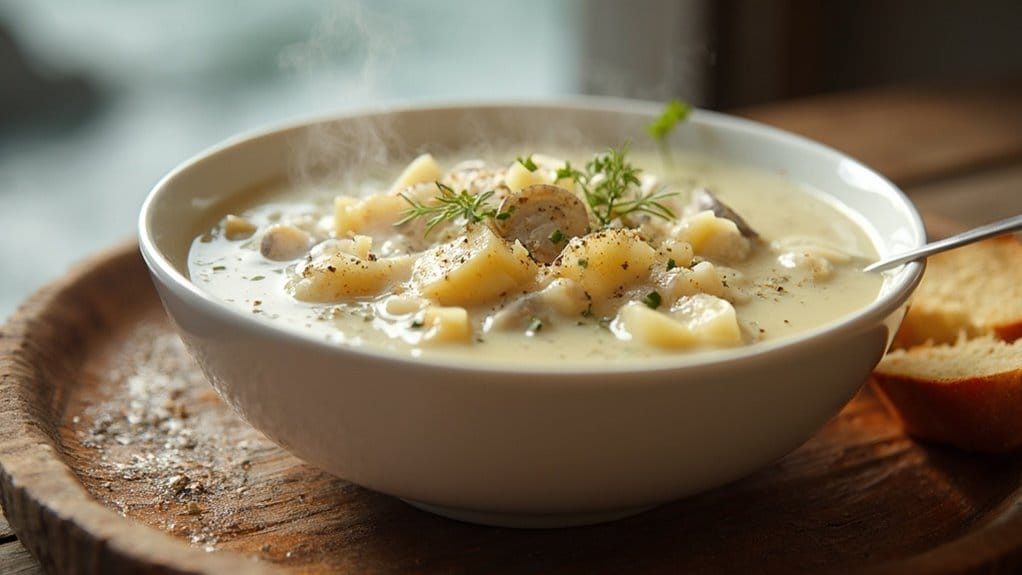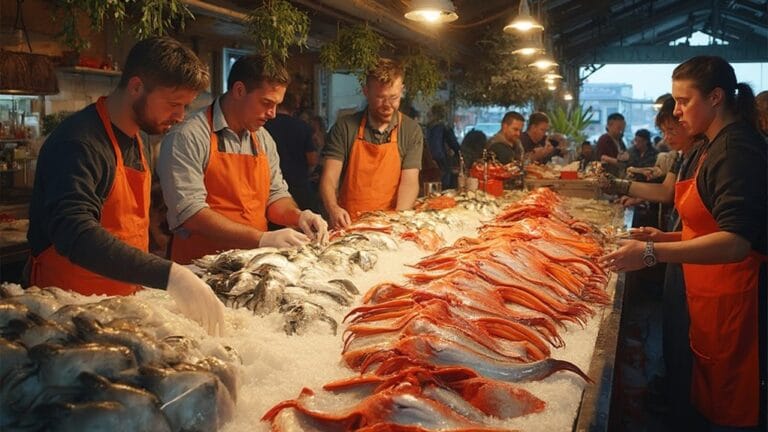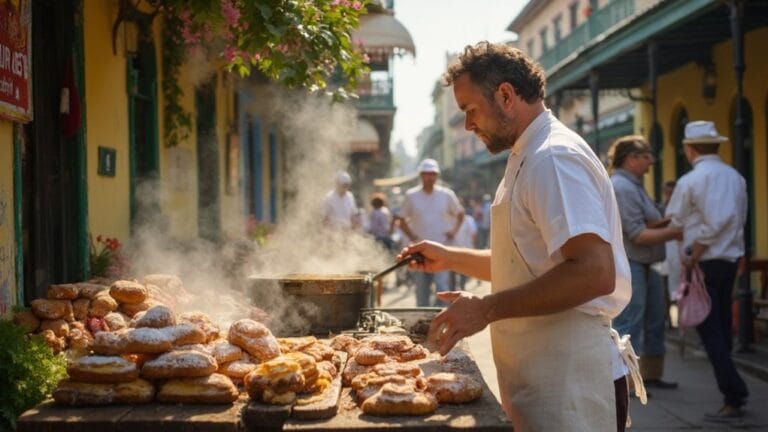When you think of Maine's best clam chowder, picture creamy, rich flavors with a touch of salty breeze. Local places like Billy's Chowder House or Thurston's whip up magic with fresh clams, potatoes, and a hint of bacon, all cozy in a bowl that warms your soul. It's not just about the ingredients; it's the love and tradition poured into every ladle. And hey, don't forget the crunchy oyster crackers for that perfect bite! If you're curious about how it all began or what's brewing in local festivals, there's plenty more to discover!
Key Takeaways
- Billy's Chowder House in Wells is renowned for its rich, buttery chowder made with fresh clams and potatoes.
- Thurston's in Bernard offers a unique chowder thickened with potatoes, aged for enhanced flavor.
- Down East Lobster Pound in Trenton features a creamy chowder that includes both clams and haddock for a delightful twist.
- The Yarmouth Clam Festival showcases community engagement with clam-shucking contests and attracts over 80,000 attendees each summer.
- The Portland Chowderfest allows visitors to sample various chowders from local restaurants, promoting Maine's diverse clam chowder scene.
Key Ingredients for Chowder
When it comes to making the perfect clam chowder, understanding the key ingredients is essential. Imagine this: you're in your cozy kitchen, the smell of sautéed onions and bacon filling the air. You've got your salt pork or bacon for that savory kick, and don't forget the butter to bring everything together. Now, let's talk about those clam varieties. Whether you choose fresh quahogs or canned gaper clams, each brings its unique flavor to the pot. Clams are also integral to family history, which adds an extra layer of significance to your chowder.
Next up, you'll want to add some hearty veggies—think diced potatoes, celery, and those aromatic onions. They're the backbone of your chowder, adding texture and depth. To achieve that creamy consistency, you can play around with thickening methods. Some folks swear by a roux made from flour, while others prefer the traditional route with crushed crackers. Trust me, oyster or Saltine crackers can work wonders!
Then, to make it all come together, you'll need the right liquids—whole milk, cream, or even a dash of chicken broth for a flavor boost. With these key ingredients, you're well on your way to mastering Maine's best clam chowder. So, roll up those sleeves and get ready to impress!
Traditional Cooking Techniques

To truly bring out the flavors of Maine's best clam chowder, mastering traditional cooking techniques is key. First off, you'll want to start with fresh clams, so be sure to source high-quality ingredients. Steaming them in a mix of water and white wine not only opens them up but adds a lovely depth of flavor. Once they're cool, shuck and chop those clams like a pro.
Next, it's all about the base. Fry up some bacon until it's crispy—trust me, that smoky goodness is essential. Leave some of that flavorful fat in the pot, then sauté onions and celery until they're tender. Don't forget a pinch of garlic for that extra kick!
Now, it's time to thicken things up. A roux made from flour and that bacon fat will do just the trick. Boil some potatoes until they're tender, then add them along with clam juice to your pot. Simmer until everything's perfectly combined, and right before serving, toss in the chopped clams and a swirl of heavy cream. Just remember, adding the clams at the end keeps them tender and delicious—nobody likes tough clams! Additionally, using fresh clams enhances the chowder's flavor and texture, making it a true clam chowder classic!
Regional Variations Explained

Clam chowder isn't just one dish; it's a delightful tapestry of regional variations that reflect the unique culinary traditions of the Northeast. If you've ever traveled along the coast, you know how each state puts its spin on this classic. New England clam chowder, often called "Boston-style," is rich and creamy, with potatoes and bacon swimming in a thick base. You can almost taste the cultural significance in each spoonful!
Then there's Rhode Island clam chowder, which ditches the cream for a clear broth, making it a lighter option that pairs perfectly with clam cakes. In fact, the absence of milk or cream makes Rhode Island chowder distinct from other styles. If you're looking for a splash of color, Manhattan clam chowder introduces a zesty tomato base, blending in veggies like peppers and carrots—definitely a twist on the original!
In Maine, the chowder's thinner and brothier, often featuring soft-shell clams. Meanwhile, Connecticut offers a mix of the two styles, occasionally using both tomatoes and cream. Each version showcases regional preferences, making every bowl a reflection of local tastes. So next time you dig into a bowl of chowder, consider the journey it's taken and the stories it tells!
Chef's Expert Tips
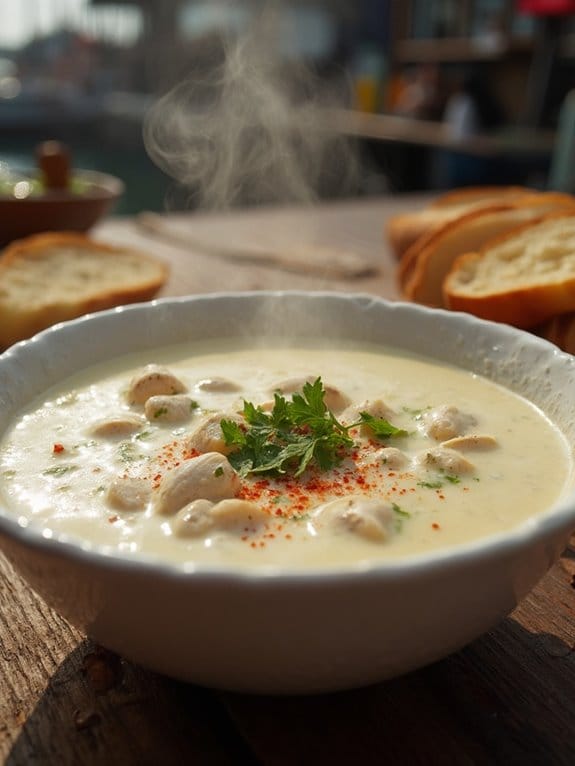
Creating the perfect Maine clam chowder involves a few expert tips that can elevate your dish from good to exceptional. First off, using fresh clams is key; skip the canned stuff! Steaming quahogs or cherrystones and saving that delicious juice is a must. When it comes to clam textures, finely chop those clams after cooking to avoid that rubbery bite.
Next, let's talk about the roux. Mix equal parts melted butter and flour until you hit that "wet sand" consistency. It's the base for an amazing chowder! And here's a pro tip: don't go overboard with the cream. Too much can make your chowder greasy. Heat your milk first, or let the chowder cool a bit before adding it in. Quality ingredients really make a difference in the overall taste and texture of your chowder.
Remember to simmer gently after you've added the milk. You want those potatoes tender, but still with a little bite. And resist the urge to thicken it up; a brothy chowder is what you're aiming for. With these tips, you'll find that perfect seasoning balance, creating a chowder that's rich in flavor and utterly comforting. Enjoy every spoonful!
Historical Context of Chowder

Tracing the origins of chowder reveals a rich tapestry of culinary history that dates back to the late 17th century. Picture it: fishermen in Brittany, France, whipping up a hearty soup with fish, onions, and salt pork, laying the groundwork for what we now cherish. When the Pilgrims landed in America, they brought this delicious tradition with them, adapting it to include local ingredients.
As chowder evolved, especially into the beloved clam chowder, it became a symbol of cultural significance for coastal communities. By the 1750s, recipes were popping up all over, each one reflecting the unique tastes of the region. You might've heard the tale of French soldiers stranded in Maine, creating a makeshift chowder with whatever they could find—potatoes, crackers, pork, and plenty of clams. Milk and cream became essential ingredients that enriched the chowder's flavor and texture over time.
It's fascinating how chowder symbolizes comfort and togetherness, right? Herman Melville even wrote about it in "Moby Dick," capturing the essence of chowder houses in Nantucket. So, the next time you enjoy a bowl, remember, you're savoring a piece of history, steeped in tradition and rich flavor!
Modern Twists on Recipes

In recent years, many home cooks and chefs have reimagined traditional clam chowder, infusing it with diverse ingredients and bold flavors. You might be surprised to find spicy innovations like Caribbean Clam Chowder, where chorizo, sweet potatoes, and colorful peppers join the classic mix. This vibrant twist proves that chowder can dance to a different beat!
If you're feeling adventurous, try swapping out the usual potatoes for green bananas and using full-fat coconut milk instead of half-and-half. This tropical touch brings a whole new vibe to your bowl. And don't forget to sprinkle in some Creole seasoning—it'll add a zesty kick that'll make your taste buds sing.
When it comes to texture, frozen clams can work wonders, giving you a fresher feel in every spoonful. New England style clam chowder is known for its rich, creamy consistency, which sets a high bar for any twist on this classic dish. And let's talk about those creative garnishes! Chopped bacon and chives, anyone? Pairing your chowder with crusty bread or cornbread elevates the experience to perfection. So go on, mix it up! Modern twists not only honor tradition but also invite you to explore a world of flavors that'll keep your chowder game exciting and fresh.
Best Local Spots in Maine

If you're on the hunt for the best clam chowder in Maine, you won't be disappointed by the local favorites that dot the coastline. One must-visit spot is Billy's Chowder House in Wells, where the rich, buttery chowder is loaded with tender clams and hearty potatoes. You'll feel like you've struck gold when you taste it!
Then there's Thurston's in Bernard, a hidden gem that serves up chowder thickened with potatoes instead of flour, giving it a unique twist. They let their chowders age for at least a day, allowing the flavors to meld beautifully. Notably, fresh clams and clam juice are essential for quality chowder, which is a key focus at many of these local establishments. Last but not least, don't skip Down East Lobster Pound in Trenton, where the creamy chowder features a generous mix of clams and haddock, making it a true local favorite.
These spots embody the essence of Maine chowder, showcasing the abundance of soft-shell clams in the area. Whether you're a lifelong fan or new to clam chowder, these places will leave you craving more. So, grab your spoon and make your way through these delicious destinations—you won't regret it!
Pairing Suggestions for Chowder

Wondering what to serve alongside your delicious bowl of clam chowder? You've got options that can elevate your chowder experience! For a classic touch, nothing beats oyster crackers. They're small, crunchy, and perfect for those satisfying dips. Saltine crackers? They work wonders too, offering a crisp contrast to the creamy chowder. And let's not forget about garlic bread—just imagine dunking a warm slice into that rich broth!
If you're feeling a bit more indulgent, go for a grilled cheese sandwich, because who doesn't love melty cheese paired with chowder? A bread bowl is also a fun twist, adding another layer of flavor profiles to your meal. For something a bit different, try pairing it with bacon-wrapped scallops or even a lobster roll—now that's a seafood lover's dream! In addition, a bowl of chowder is often enhanced by toppings like bacon bits that add a savory crunch.
If you want lighter options, steamed asparagus or a fresh green salad with vinaigrette can add a revitalizing contrast. Whatever you choose, don't forget about chowder toppings like crispy bacon or fresh herbs to really make your chowder pop. Enjoy your chowder journey; it's all about finding that perfect pairing!
Clam Harvesting Practices
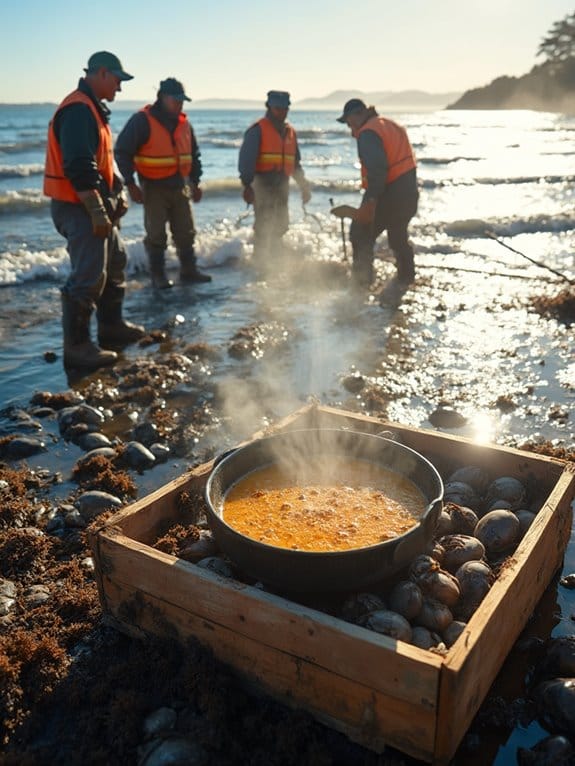
Pairing chowder with the right sides can enhance your meal, but understanding the clam harvesting practices that bring those clams to your bowl is equally important. When you dig into your chowder, you're enjoying the fruits of Maine's deep-rooted clam culture, dating back to 1821. Envision this: certified shellfish wardens overseeing the process, ensuring that clam conservation and harvesting ethics are front and center.
Now, let's talk tools. The trusty clam fork and a sturdy bucket are your best pals during harvesting. You'll want to hit the beach at low tide, scanning for those oblong clam holes. It's like a treasure hunt! Just imagine gently pulling the sand back to uncover those delicious soft-shell clams or even the elusive razor clams. But remember, there are limits—only 1 peck per day for recreational harvesting, and size matters too. Additionally, local regulations vary by town based on available resources, so it's essential to check before you head out.
With competition fierce and commercial licenses in short supply, every clam counts. So, the next time you savor that rich, creamy chowder, think about the careful practices that bring those clams to your bowl, and enjoy knowing you're part of a sustainable tradition!
Popular Chowder Festivals in Maine

Maine's chowder festivals are a seafood lover's paradise, showcasing the state's rich culinary heritage. You can't miss the Yarmouth Clam Festival, held every summer during the third full weekend in July. With over 80,000 attendees, it's a bustling hub filled with energy! Envision this: a clam-shucking contest, a lively parade, and even a diaper derby—yes, you heard that right! The community involvement is heartwarming, as locals come together to celebrate their love for clam chowder. Over 3,000 volunteers help make the festival a success, ensuring that everything runs smoothly and everyone enjoys the festivities.
Then there's the Portland Chowderfest, happening on Saturday, April 26th, 2025. This festival really puts the fun in chowder tasting! Local restaurants compete for the Best Chowder title, and you get to sample a variety of chowders, all while feeling like a culinary judge. You'll get a passport that lets you taste from every vendor, making it an unforgettable afternoon.
Frequently Asked Questions
What Type of Clams Are Best for Chowder?
For the best chowder textures, you'll want to use clam varieties like quahogs, littlenecks, or cherrystones. They offer tender flesh and a briny flavor that truly enhances your chowder's overall taste and experience.
How Long Does Clam Chowder Typically Last in the Fridge?
When it comes to clam chowder storage, you've got about 3 to 4 days in the fridge. For reheating tips, just warm it up gently, ensuring it reaches a safe temperature. Enjoy every spoonful!
Can I Freeze Homemade Clam Chowder?
Yes, you can freeze homemade clam chowder! Just follow freezing tips like cooling it first and using airtight containers. For reheating methods, thaw it overnight in the fridge and gently warm it on the stovetop.
What Are Common Allergies Related to Clam Chowder?
While clam chowder's creamy delight tempts many, it can trigger clam allergies and seafood sensitivities in some. It's crucial to recognize symptoms and consult a healthcare professional if you suspect an adverse reaction.
How Can I Make Clam Chowder Gluten-Free?
To make clam chowder gluten-free, use gluten substitutes like gluten-free flour for thickening. You can also incorporate other thickening agents, such as cornstarch, to achieve that creamy texture without compromising flavor or consistency.

